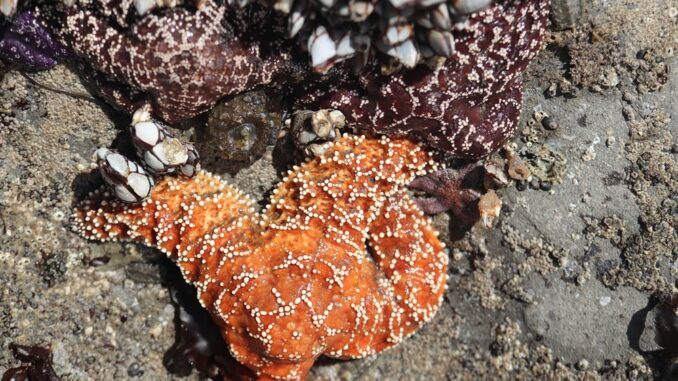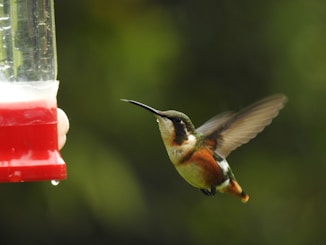
When the tide slowly fades into the negatives at Rialto Beach, the ocean reveals a hidden world – massive undersea boulders and shimmering tide pools. These spaces feel like ancient secrets starting you out on an adventure. From the unassuming shores near the parking lot, the scene is quiet, stretches of dark sand and clusters of pebbles stretch out to sea. As you walk north along the rugged coastline towards the legendary Hole in the Wall, the landscape transforms. The clusters of pebbles turn into scatters of broken shells and small rocks which grow into hulking boulders, each one uniquely shaped by centuries of crashing waves and salt-laced winds. Anchored deep in the muddy seabed, these monoliths refuse to budge, defying the pull of the ocean with a quiet, immovable strength.
It is around and on these silent stones where normally hidden creatures, like sea stars, will hold their places adjusting to the change in their usual haunts. Sea stars (commonly known as star fish) are my favorite tide pool creature.

Sea stars thrive in salt waters, clinging to rocks and slowly roaming ocean floors. Although sea stars, like fish, breathe through gills, their gills are quite different. Sea stars rely on skin gills called papulae. The papulae are tiny pimple like bumps on the outside of a sea star.
Since they breathe though gills then how do sea stars survive a low tide, especially a minus tide? Most sea stars can survive out of water on average 5 minutes. I know it is tempting to want to “help” them back into the water, and one might take this as an opportunity to snatch them out of the water and hold them, but both are best left undone. Some scientists suggest a sea star will suck in extra water when the tide is going out to protect themselves. Sea stars are well adapted to changing tides, as you explore tide pools, avoid picking up or peeling off any sea creatures you find. Although these animals experience tidal changes regularly, they are in a vulnerable state – focused on avoiding predators and conserving energy until the tides return to cover their homes.

While exploring the shores you will find not every slippery, or dry, boulder will have a creature on or around it. Sometimes you need to traverse through changing tides or over the muck and seaweed covered rocks. Having good footwear is important. Occasionally I do go barefoot in tide pool areas. It’s important to be extra careful not to cut your bare soles on the sharp shells of barnacles. No matter what covers your feet, you should always look where you walk as you don’t want to accidentally crush tiny fish stuck in the pools of a rock formation or squish a sea cucumber hiding in the shadows or crush new barnacles just forming their shells.
The dark crevices are often where creatures like to lurk, giving them extra protection from the sun rays, and predators on the prowl. If you look close enough you may just see what I saw on a recent trip. There was, what I dubbed, a wall of stars and one was in the midst of a meal.

Sea stars are one of the carnivores of the oceans. When I think of aquatic carnivores my mind immediately thinks of sharks, whales, seals, and dolphins. Sea stars like to eat mollusks, such as clams, mussels, and oysters. The way they eat is fascinating. The suction cups on the bottom of their limbs are used to pry open the shells. Their stomachs emerge from their mouths (which is the small hole in the center of their underside) and slip into the opening they just created. It then covers the prey like a Ziplock bag and begins to break down and digest the food. Once it is done the stomach slinks its way back inside. Sea stars generally eat every day, though some go for a few days without eating anything.

If we look closely, we can find similarities between humans and sea stars. Living in the Pacific Northwest I know many people who enjoy eating mollusks. Another similarity is sea stars come in different colors, and sizes, however, sea stars have a wider variety of colors. Sea stars often sport five spiky arms, but some dazzle with a whole constellation of limbs. One species can have up to 40 arms! Their sizes range around 4 inches to just under 10 inches. Some can even weigh up to 11 pounds. That is like the weight of an average cat, or a gallon of paint, or 2 chihuahuas in a basket! I have never seen a sea star that big on the shores of the ocean.
Tide pools in nature don’t last forever. Remember to check the tide charts and arrive at least 30 minutes before the tide is at its lowest. If you arrive when the tide starts turning you might just miss the beauty the ocean is exposing. Negative tides make the beach bigger, meaning you will have further to walk to get to where nature reveals hidden wonders.

Even if you don’t live near a natural resource that creates tide pools, many aquariums have tide pool exhibits. Some of these exhibits are touchable, giving guests the chance to feel the creatures that live underwater. There are many opinions about aquariums, for me I view them as an opportunity to learn about a world you may never be able to see in so much depth. I don’t have the courage or strength to be an undersea diver, it’s hard for me to even snorkel, and yet I love the undersea world. Aquariums also generally have a wider variety of tide pools creatures than you will see on the shores in nature. They also give you the chance to see even bigger creatures! Unless of course you are a diver, then the possibilities are endless!
Even though I live near a few options of locations I can explore as the tides are out, I do not always find what I am looking for, but when I do it is spectacular.

If you are drawn to the quiet secrets of the depths, and want a glimpse into underwater life, tide pooling offers a fascinating way to connect. Solo or with curious companions, it invites us to slow down, observe closely, and marvel at the resilience of life. It is an adventure that is both educational and enchanting.
Remember to tread lightly. These temporary tide pool worlds are fragile, and the sea creatures within them deserve our care and respect. As we explore, may we do so with curiosity, gratitude and care. Remember much beauty lies in the overlooked and the temporary.



All photos taken by Maria Densley at Rialto Beach, WA near the Hole in the Wall




Be the first to comment